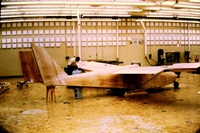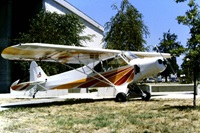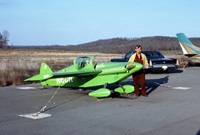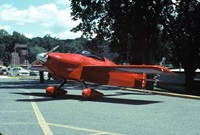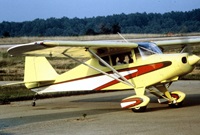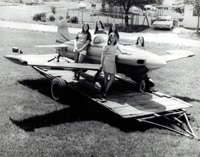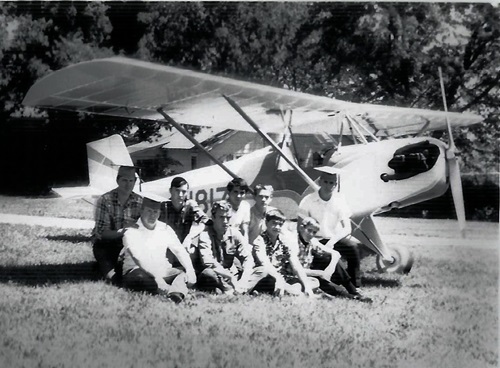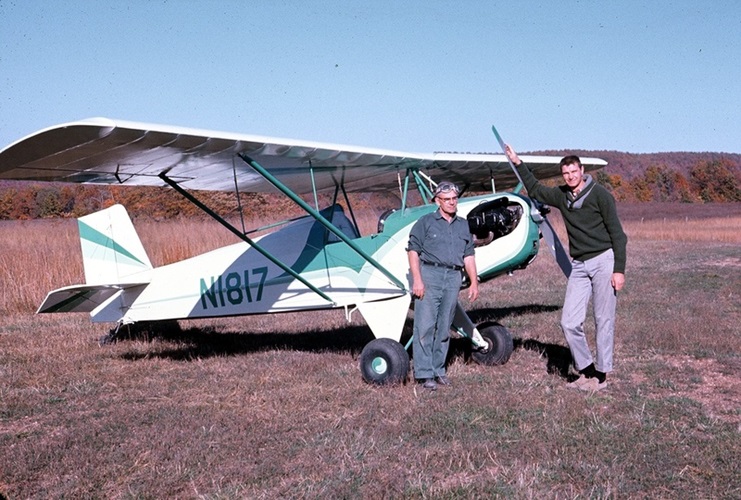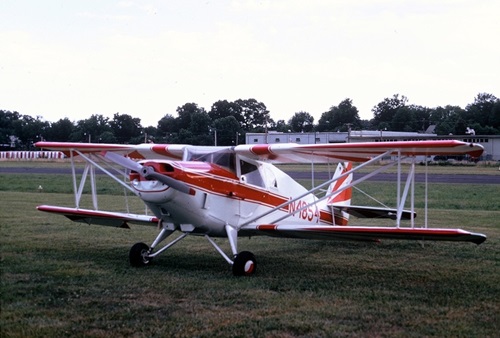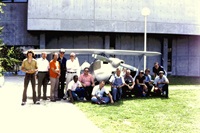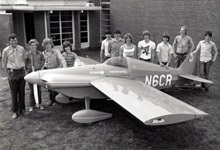"THE NORWOOD PROJECT WAS A HOVER CRAFT. THIS PROJECT LAUNCHED THE SCHOOL CRAFT IDEA FOR ME. IT EARNED LOCAL AND NATIONAL AWARDS AND WAS DISPLAYED AT THE CHICAGO MUSEUM OF SCIENCE AND TECHNOLOGY. CIRCA 59-60" ~Bill Ghan
The Beginning:
Where did the idea of a Project School Flight start? For Bill Ghan, it could have started during WW2 while living in Plainview Kansas near the Boeing B-29 plant. As a boy, Bill would nail boards together to make airplanes that he could attach to a string and "fly." Or, it could have started when he was a little older building airplane models. Perhaps it started even later in life, but Bill says it was all of the above.
Bill started flying lessons at age seventeen: he soloed about a year later. In college Bill learned of a person killed in a plane that he had built himself. To Bill this sounded very dangerous and he remembers wondering who would do a thing like that?
In 1959 Bill had attained his private pilot license, and he started his teaching career as an industrial arts teacher at Norwood, Missouri. It was a small Ozarks school and the shop was a converted WW2 military bunkhouse. There were not a lot of tools to work with.
In the area where Bill lived at the time, he met Andy L. Anderson (of antique aircraft fame) who became Bill's aircraft construction mentor. Andy invited Bill to visit any time and watch him and his employee work. This Bill did almost every day after school.
In Bill's drafting class, after students had learned the "basics," Bill challenged his students to research a mechanical device that they were interested in. Students were then asked to write a paper about the device and make a mechanical drawing of their subject. Two students teamed up and researched a hover craft. Hover crafts were new at the time and were featured in the magazine Popular Science. These students sent off for information about the hover craft listed in the article. They received a booklet from one university's hover craft project. With the information gathered, Bill's students made drawings and built a model using an electric motor for power. The model was a success and would hover and scoot across the shop floor.
With the success of the model, and the students' report, plus the literature the students had received on hover craft, Bill decided that a full sized model could be made in his metal working class with the original two students as well as the others in his class. The crafts' framework was built of aircraft tubing which was something Bill knew about having observed and worked with Andy Anderson. A welding torch was borrowed, and electrical conduit was purchased to use as tubing for the hovercraft. The students built a round "jig" to shape and fit the tubing in order to ready it for welding. Tubing braces were placed where needed.
A WW2 drone plane engine that came with a propeller was purchased for a power plant for the hover craft. This was attached to the frame. Next, the airframe was covered with muslin, sealed with nitrate aircraft dope and painted. The engine was started and the craft lifted off and hovered in place. It would not, however, lift a person. After installing a skirt at the air outlet and a seal in front of the prop, it would lift both itself and a person. The hover craft worked well on a level surface, but would slide down hill on a non-level plane. The craft needed more power. Guidance was achieved by the pilot shifting his weight.
The hover craft won the top prize at the local spring industrial contests. It was shipped to Dearborn, MI to the Ford Motor Company's International Industrial Education Contest. There it earned a top prize consisting of a trophy and a monetary reward for the students.
Ford Motor company then displayed the craft at the Chicago Science and Technology Museum. Ford offered to purchase the craft, but Bill's students did not want to sell and refused the offer. When the craft was returned to the students, the inside was dirty and oily from having been extensively ran.
Perhaps this is how a beginning teacher with the enthusiasm of youth started doing Project School Flight, although it was not named that yet. The term Project Flight was coined by the Experimental Aircraft Association. Bill says he was not the first, nor will he be the last person to build an aircraft in an educational setting. "It came about by my interest in aviation and giving students something real to work with and learn about."
Developing the Concept:
After the hovercraft success, Bill decided to attempt an aircraft building project with his students A friend had an engineless Common Wealth Aircraft frame and wings that he would donate. Another friend offered to sell an engine for one hundred dollars. All that was left to do was repair, clean, cover, and paint the plane. Bill approached his superintendent with the "idea." The superintendent was reluctant to approve the project on his own, so he contacted the State Department of Education for their input. The letter received from the Dept. of Education stated that airplane construction did NOT deserve a place in high school education. Needless to say, the project was stopped.
The concept of student constructed airplanes was difficult for people to accept. Why do it? Could the students construct a plane that was safe to fly? "Aviation always has its detractors caused by lack of knowledge," says Bill. " So perhaps part of this concept was to educate the public as well as the students."
Bill later accepted a position at Cabool R-4 School. There were few metal working tools in this shop as well. The second year there, Bill did not have enough students enrolled in his metal working class. The superintendent called Bill in and told him that due to a lack of interest in the class, he would have to teach study hall that hour instead. That motivated Bill to discuss with the superintendent the lack of metal working tools in the shop, but with the tools on hand they could build an airplane. Bill also pointed out that dropouts from other classes could join his class, or some of the students that were in study hall could join his class. This got the superintendent's attention.
Bill furthered his cause by telling his superintendent that an airplane could be built with no expense to the school. That was a very good selling point for the project. Over the summer, Bill put a plan in motion to build an aircraft in an educational setting.
Andy L. Anderson offered to fund an aircraft project that he wanted and had plans for. A contract of agreement was written and signed between the school, sponsor, and the teacher. Bill approached his superintendent who was impressed. Bill discussed the earlier letter from the Department of Education stating that there was no place for airplane construction in a high school setting, and the superintendent assured Bill that the class would not be named aircraft construction. The contract was approved by the school lawyers, and the class was approved. A Corbin Baby Ace Model-D was built by Bill's students in only one year. The class was a success! The next year, there were too many students enrolled to take the class.
The plane was entered in the local Summit Conference Industrial Arts Fair and the Southwest MO Industrial Arts Fair where it was out scored by a fur covered foot stool and a small wicker basket....justify that. The plane flew great. Bill even won a spot landing contest at Mountain Grove in it.
During the building of the Baby Ace, the State Department of Education's director of Industrial Vocational Education visited Bill's school. He saw what was happening there and all of the enthusiasm for the project. Right there, he invited Bill to speak to the Spring Industrial Vocational Conference at the Missouri University in Columbia. This was quite a turn around from the first letter stating that there was no place in high school education for aircraft building.
Pictured below is the Corbin Baby Ace Model-D.
Going forward:
The second, and last, plane constructed by the Cabool R-4 school students was a Cabin BiPlane named the KG Special. The plane was designed by Dr. Harry B. Kelly, DDS and Bill Ghan. During the class, students drew the plans and constructed the plane. This project continued on into a second school year as both drawing and building the plane took more time. The completed plane was taken to the West Plains airport, assembled and flown. Bill Ghan was the first to fly this plane
.
Soon after the success of the KG Special, Bill was asked to speak to a University of Wisconsin class conducted for teachers at the EAA Convention at Oshkosh, WI. Dr. Charles Thomas conducted the class. His students were excited about the program and wanted more hands on experience. Bill had seen the Sonerai 2 airplane at the convention. After talking to the designer of the Sonerai, John Monet, Bill understood the amount of time it would take to build the plane and decided that the project would fit into the allotted time frame of two weeks.
Dr. Thomas and Bill worked together to formulate a plan for building the Sonerai 2 in the two week period with 20 students. Dr. Thomas took care of the student enrollment, and secured the shop space at the University of Wisconsin-Stout Campus in Menomonee, Wisconsin. Bill secured the sponsors, ordered the necessary materials and delivered them to Stout for the start of the class. The class ran all day for two weeks. The plane was completed and towed to the Oshkosh EAA Convention for display. There was so much interest shown in the plane that a second class was considered. However, due to the work pressure, the class was extended to a three week period. In total, five aircraft were constructed at the University of Wisconsin-Stout campus. Four were Sonerai 2's and the other plane was an all wood amphibious airplane called the Esperanza.
Moving Back to Missouri:
After five summers away from his home in Mansfield Missouri, Bill decided to stop doing the University of Wisconsin-Stout workshops. During these same years, Bill's Mansfield students built five school flight projects. A Bushby Mustang One, a Sonerai One, a Skybolt BiPlane, an Albee Sport BiPlane, and a Quickie Canard plane.
While teaching at Mansfield, Bill also taught night classes at Missouri State University for ten years. The classes were basic flight 188 and 189. While teaching at Missouri State, a former Stout workshop student inquired about sponsoring an aircraft construction workshop at his college which was Southeast Missouri State College. Bill mentioned this to his industrial arts director at Missouri State who suggested the workshop be conducted at Missouri State in Springfield. This was done, and three planes were constructed there. They were: a Wagabon, a Super Cubby, and a Christen Eagle BiPlane.
Retirement:
Bill retired from education in 1995. He had taught for thirty-six years. Bill spent 53 years of his life in school either as a teacher, or as a student. Teaching was a large part of Bill's life. After retirement, Bill continued to pursue his aviation interests with EAA Chapter 1218.
On His Own 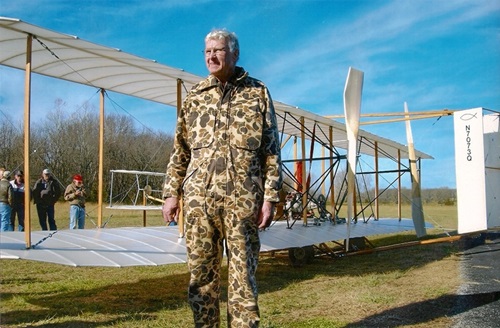
Bill constructed three aircraft on his own initiative. They were in order; a 1911 Curtis Pusher, a Scampy BiPlane, and a Wright Flyer. The Wright Flyer was built to celebrate the one hundredth anniversary of flight. Bill is quick to point out that no one ever builds an aircraft by himself. Indeed, he has built many airplanes with many other builders.
EAA Chapter 1218:
Bill is a Charter Member of Chapter 1218. He helped with the construction of the chapter hanger and meeting room. He was instrumental in building the chapter Pietenpol Air Camper, and has led the team on reconstructing an EAA BiPlane which is still a work in progress. Bill has advised and assisted on several Chapter 1218 members' projects.
Awards for William Ghan: The Teacher, The Aviator, The Builder.
EAA Aviation Achievement Award 1979.
EAA Presidents Award 1983
Missouri House of Representatives Resolution 1985
Industrial Arts Association of Missouri Teacher of the Year 1985
American Industrial Arts Teacher of the Year. 1985
Who's Who Among American Teachers 1988
EAA Homebuilders Hall of Fame 1997
EAA Major Achievement Award 2004.
Bill has given many speeches, has published many articles, and has been featured on many television and radio programs.
More Project School Flight Airplanes
THE CABIN BIPLANE IS THE KG SPECIAL. IT WAS DESIGNED BY DR HARRY B. KELLY, DDS OF WEST PLAINS AND MY SELF. STUDENTS DREW THE PLANS AND CONSTRUCTED THE PLANE. 1968 TO 1971.
MISSOURI STATE UNIV. PLANES WERE; A SUPER CUBBY - WITH AN INDIAN PAINT JOB, A WAGABON - YELLOW EAA PAINT, AND A CHRISTEN EAGLE BIPLANE.
Bill's Planes: THE UNIVERSITY PROJECTS WERE FOR TEACHER TRAINING AND WERE THREE WEEK CLASSES. THE UNIVERSITY OF WIS STOUT PLANES WERE MONETT SONERAI 2s' AND ONE ALL WOOD AMPHIBIOUS PLANE THE ESPERANZA

